Igor Stechkin, an ingenious firearms designer mostly known for designing the APS automatic pistol, had a number of other interesting firearms designed during his career which became forgotten or known to only a small group of firearms enthusiasts because these guns were never adopted. Today, thanks to the Kalashnikov Guns Magazine, we have a chance to take a look at the TKB-0146 rifle: one of the most complicated creations of Igor Stechkin which was his submission to the Abakan trials.
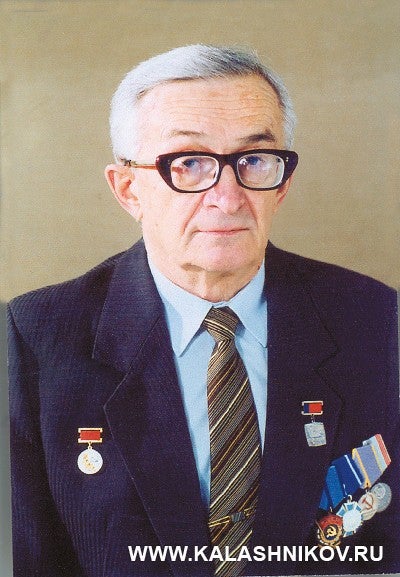
Igor Stechkin
Abakan trials started in the late ’70s with a goal to adopt an advanced weapon system that would increase the hit probability and accuracy of rounds fired in full auto or burst fire modes. In order to achieve these goals, the designers started working on concepts that would allow eliminating the user error and influence of the recoil on the accuracy. There were two main design concepts that were supposed to achieve these goals: balanced action and delayed recoil impulse action. In the case of balanced action, the reciprocating parts of the firearm are divided into two subassemblies which have equal mass, move in opposite directions and have some sort of linking mechanism that synchronizes their motion. The delayed recoil impulse mechanisms consist of an outer chassis that is held by the shooter and the actual firearm recoiling back in the chassis. In such a system, once the first round of a burst (normally two-round burst) is fired, the gun starts moving rearward inside the chassis and during this motion, it extracts, ejects, feeds and fires another round before hitting the rear wall of the chassis. As a result, the recoil of the first fired round is not transferred to the shooter and the soldier only feels the combined recoil of the burst. In conjunction with the high rate of fire, this system allows having minimal to no interference between the two shots.
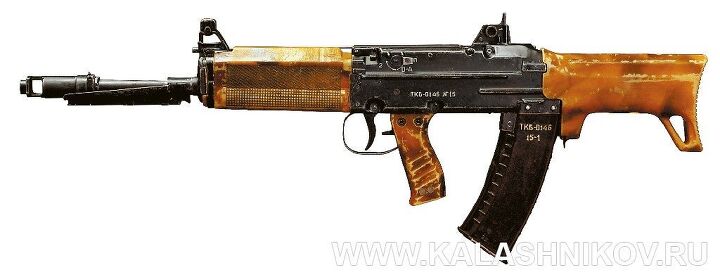
From the eight firearms submitted to the Abakan trials, only Stechkin’s TKB-0146 and Nikonov’s designs were utilizing the delayed recoil impulse system. Also, Stechkin’s rifle was the only bullpup submission to the trials. Ultimately, the delayed recoil impulse system proved to be superior in the trials because the Nikonov’s rifle was adopted in 1994 as the AN-94 rifle. Interestingly, during the trials, Nikonov’s first rifle called AS used a reciprocating magazine which proved to be a poor solution and Nikonov eventually redesigned the rifle and introduced the ASM rifle which had a non-reciprocating magazine. Stechkin has solved this problem from the get go and TKB-0146 never had a reciprocating magazine. Stechkin figured out the two-stage feeding system earlier which allowed him to design a gun with mobile action and static magazine. We’ll get to the description of this system in a moment.
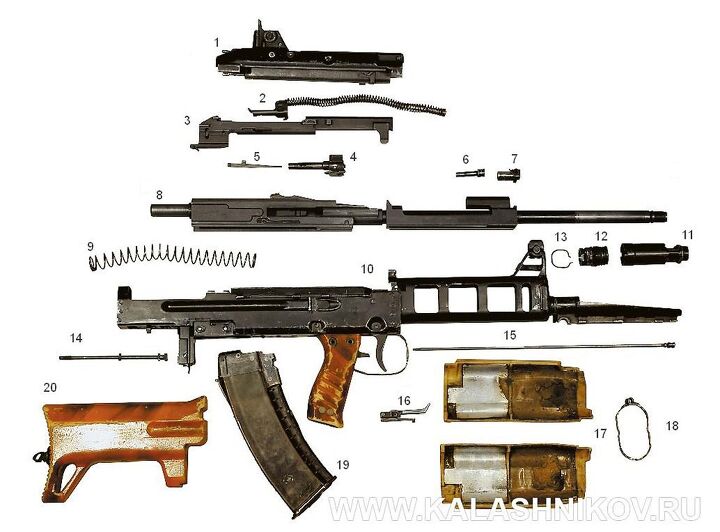
1 – Top cover of the receiver with the hammer mechanism; 2 – Recoil spring assembly; 3 – Bolt carrier; 4 – Bolt; 5 – Firing pin; 6 – Gas piston; 7 – Gas block plug; 8 – Barel/receiver assembly; 9 – Return spring of the barrel/receiver assembly; 10 – Chassis (outer receiver); 11 – Muzzle device; 12 – Sleeve; 13 – Sleeve spring; 14 – Stock attachment pin; 15 – Cleaning rod; 16 – Charging handle; 17 – Handguards; 18 – Handguard retainer; 19 – Magazine.
TKB-0146 is a gas operated firearm with a short stroke gas piston. The rifle is chambered in 5.45x39mm. The lockup of the action is accomplished via a rotating bolt. The rifle has an overall length 970mm (38″) with a barrel length of 420mm (16.5″). The empty weight is 3.8 kilograms (8 lbs 6 oz).
The safety selector of the TKB-0146 rifle is located on the left side of the gun and has three positions: “П” – safe, “О-А” – single shot/full auto, and “2” – two round burst. If the O-A mode is chosen and the trigger is pulled halfway, the gun will shoot in semi-auto mode. When the trigger is pulled all the way back (on the same selector position), the gun will fire in full auto at a rate of fire of 600 rpm. The way this rifle works in two round burst mode is the most interesting. In this mode, the rate of fire of the burst is 2,000 rounds per minute.

Initially, the rifle was designed to be fed from a quad stack 60-round magazine. However, because the design of these high capacity magazines was not refined and had some reliability issues, they had to rivet metal inserts into the magazine well to make it possible to feed from standard 30-round 5.45x39mm magazines. The grip cavity is designed to house the cleaning kit.
In the two-round burst mode, when the first round is fired, the receiver and barrel assembly along with the BCG start to travel rearward. During this rearward motion, the BCG manages to extract and eject the fired case then feed and fire a fresh round which was previously stripped from the magazine and got ready to be fed in a sort of a secondary/intermediate feeding position in the receiver. Interestingly, the first round is fired by the strike of the hammer which, by the way, is mounted upside down on the top cover. However, the second round of the two-round burst is fired by the bolt carrier extension hitting the firing pin once the action is closed (much like in many open bolt machine guns). This solution is deployed because by the moment the second round is fired, the BCG has traveled back far enough to be out of reach of the hammer. Right after the second round is fired, the whole reciprocating system finally reaches its rearmost position and hits the rear wall of the outer receiver/chassis of the rifle transferring the recoil energy of the two-round burst to the shooter.

Two-stage feeding system of TKB-0146. 1 – round in the magazine; 2 – round in the secondary feeding position; 3 – round in the chamber. Before being fed into the chamber, the cartridge is first placed into the secondary feeding position.
Because of the feeding mechanism shown in the above-embedded image, in order to charge the gun when a new magazine is inserted, the shooter needs to pull and release the charging handle twice. When cycled the first time, the BCG strips a round from the magazine and places it into the secondary/intermediate feeding position and when the charging handle is racked the second time, the BCG feeds the round from the intermediate position into the chamber and simultaneously strips another round from the magazine onto the intermediate feeding position. Unloading process of the gun also involves racking the charging handle twice. After removing the magazine and racking the charging handle, the BCG will extract and eject the chambered round and feed the round from the intermediate position into the chamber. Cycling the action the second time will extract and eject the round from the chamber and because there are no rounds in the interim feeding position, the gun will become empty.
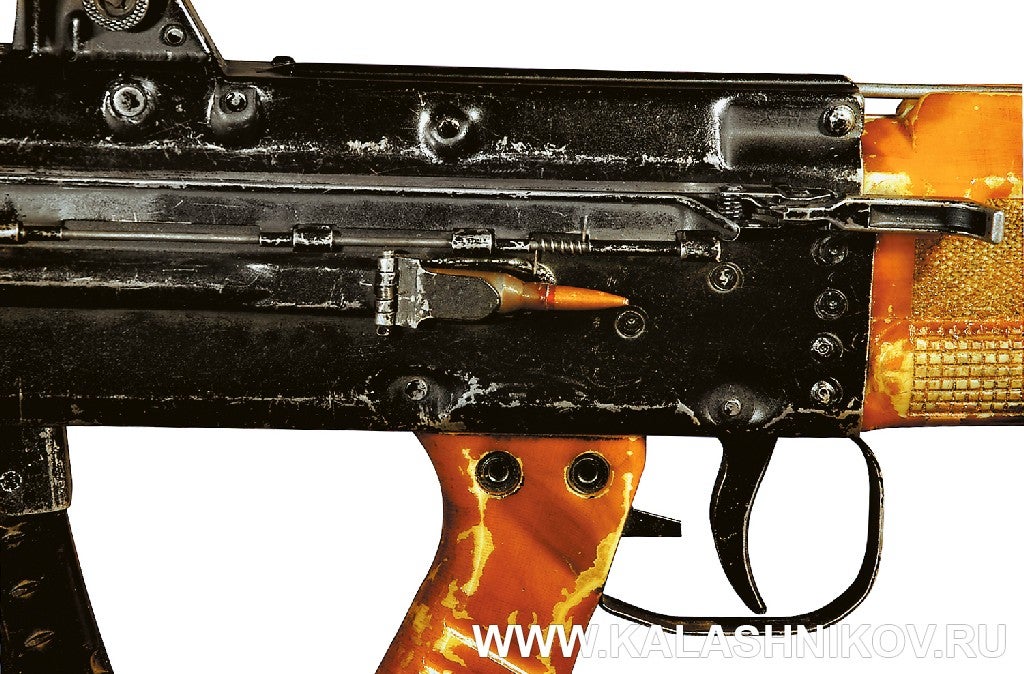
Note the 5.45x39mm cartridge being ejected forward and the small dust cover of the ejection port.
Another interesting feature of the TKB-0146 rifle is the forward ejection mechanism where the spent cases are pushed and ejected forward from the ejection port located behind the non-reciprocating charging handle, right above the pistol grip as shown in the above image. On its rearward motion the BCG extracts the spent case and places it in the ejection channel, then on its forward motion, the BCG extension pushes the extracted case forward, out of the gun.

TKB-0146 also has a lowered cheek rest portion which eliminates the need of having excessively elevated iron sights. As you can see in the above image, the iron sights have quite a low profile. The aperture rear sight is mounted on the top cover of the receiver and has six positions: П, 1, 2, 3, 4, and 5. The numbers designate the distance to the target in 100 meters. “П” setting is most likely identical to that of the Kalashnikov rifles and should also mean “permanent” (Постоянный, postoyanniy). The rifle had no provisions for mounting scopes.
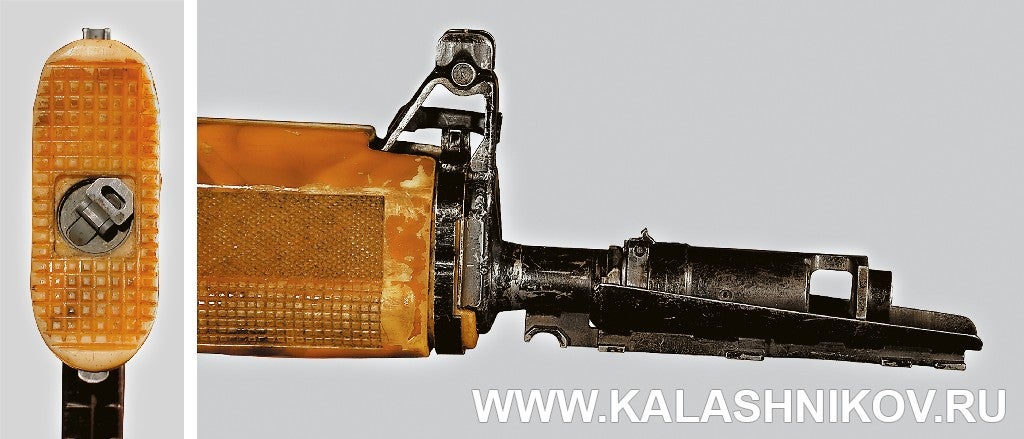
The slant extension under the muzzle device has a series of lugs allowing to attach grenade launchers and bayonets. Because the barrel of the rifle moves back in the two-round burst mode, attaching a bayonet to the barrel would add weight to the moving parts and potentially drive the gun out of battery when applying pressure on the bayonet.
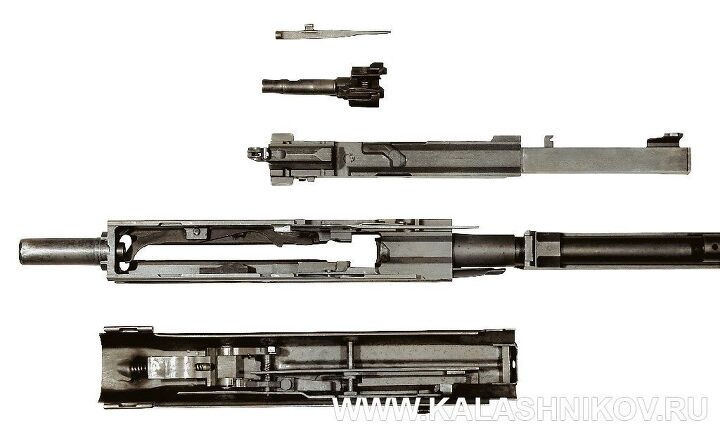
With all its advantages and drawbacks, this rifle is a true gem of the firearms history and technologies. To me, it looks to be a much simpler design than the winner of the Abakan trials – the AN-94 rifle. Probably, if Stechkin had enough time to refine this gun, he could outperform Nikonov’s rifle.
This particular TKB-0146 rifle is kept in the vault of Military Historical Museum of Artillery, Engineers and Signal Corps which is located in Saint Petersburg, Russia.
Sources:
Degtyaryov M. (2018, July 26). “«Абакан» Игоря Стечкина. Автомат Стечкина ТКБ-0146.”. Kalashnikov Gun Magazine. Retrieved from: https://www.kalashnikov.ru/abakan-stechkina-avtomat-stechkina-tkb-0146/
Images from www.kalashnikov.ru
 Your Privacy Choices
Your Privacy Choices
